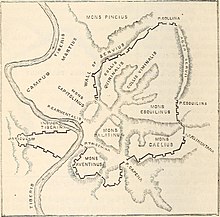Porta Querquetulana
Today we are going to dive into Porta Querquetulana, a topic that has captured the attention of many people as of late. Porta Querquetulana is a topic that covers many areas of interest, from science to entertainment, including social and cultural issues. In this article we will explore different aspects related to Porta Querquetulana, from its impact on society to the advances that have been made in this field. Additionally, we will discuss the controversies and challenges Porta Querquetulana is currently facing, as well as possible solutions and future prospects. Get ready to delve deeper into the fascinating world of Porta Querquetulana!

The Porta Querquetulana or Querquetularia was a gateway in the Servian Wall, named after the sacred grove of the Querquetulanae adjacent to and just within it. The grove appears not to have still existed in the latter first century BC.
The location of the gate is problematic. Lawrence Richardson located it at the edge of Regio V Esquiliae, with the Clivus Scauri passing through it. Platner located the gate and the wood on or near the Caelian Hill, but between the Porta Capena and the Porta Caelimontana. The Caelian Hill was supposed to have been named Mons Querquetulanus before it was settled by Caelius Vibenna and named for him, and the location of the gate on the Caelian is based in part on the earlier name.
In the early twenty-first century, photogrammetric data and 3D visualization have suggested that the grove of the Querquetulanae may have been incorporated into the Gardens of Maecenas. A nymphaeum from the time of Hadrian would have replaced the natural spring within it. In this view, the grove was located in Regio III, along the Via Labicana. A location on the Esquiline Hill is also possible. Pliny places the Porta Querquetulana between Jupiter Fagutalis and the Viminal Hill, and thus within the Esquiline.
References
- ^ Chrystina Häuber and Franz Xaver Schütz, "The Sanctuary Isis et Serapis in Regio III in Rome: Preliminary Reconstruction and Visualization of the Ancient Landscape Using 3/4D-GIS-Technology," Bollettino di archeologia online, vol. spec. D (2010), p. 85.
- ^ As implied by Varro, De lingua latina 5.49; Richardson, A New Topographical Dictionary, p. 233.
- ^ Richardson, A New Topographical Dictionary, pp. 25, 90, 332.
- ^ S. B. Platner, A Topographical Dictionary of Ancient Rome (London 1929), p. 413.
- ^ Palmer, The Archaic Community of the Romans, p. 119.
- ^ Häuber and Schütz, "The Sanctuary Isis et Serapis," p. 85.
- ^ Kim J. Hartswick, The Gardens of Sallust: A Changing Landscape (University of Texas Press, 2004), p. 14.
- ^ Pliny, Natural History 16.37; Palmer, The Archaic Community of the Romans, p. 119.